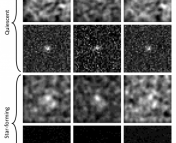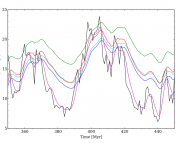Title: Strangulation as the primary mechanism for shutting down star formation in galaxies
Authors: Y. Peng, R. Maiolino, & R. Cochrane
First Author’s Institution: Cavendish Laboratory, University of Cambridge, Cambridge, UK
Status: Published in Nature
Cold gas in galaxies, through a dramatic and chaotic interplay of turbulence, magnetic fields, and of course, gravity, is transformed into the hot, radiant stars that punctuate the darkness of the universe. They live fairly quiet lives as they steadily generate helium by hydrogen fusion in their cores; those bequeathed with extra mass eventually produce elements heavier than helium (which astronomers generically call “metals“) and can return a significant fraction of their mass to their surroundings. The most massive stars die in supernova explosions, in which they release vast quantities of the metals they generated (as much as tens of solar masses!) back to the gas in which they were born, from which another generation of stars form.
For gas they are, and to gas they return. This starry life cycle unfolds in galactic nurseries; reenacted repeatedly, stars readily proliferate, increasing their parent galaxy’s stellar mass. The cold galactic gas—and thus the stars that form from them—grow increasingly metal-rich. To sustain the cycle, galaxies siphon new, pristinely metal-free gas from the vast filamentary networks in which they are embedded. Massive galaxies are additionally fed as the hot, dense gas that surrounds them cools.
It’s not easy work. Decades of cataloging galaxies have revealed two distinct types: ones in which star formation is actively, vigorously, taking place, and a second group that doesn’t. This second group of galaxies, often described as “red” (due to the abundance of cool, old stars), “dead,” or “quenched,” once formed stars too, but in a long, bygone era.
What could have stopped the star-forming work of these galaxies? There’s a number of possible reasons that revolve around a galaxy’s ability to secure a constant supply of cold gas—turn off the supply, and in a few billion years, the galaxy will cease to form new stars and “die.” It’s possible that galaxies may, rather self-defeatingly, speed their own deaths—a typical star-forming galaxy irretrievably spouts its gas into its surroundings at a rate comparable to the rate at which it converts gas into stars. For those galaxies that find themselves in a group of galaxies, the perils multiply: a galaxy’s supply of gas can be rudely shut off as it first approaches a crowded group of galaxies—a process called “strangulation”—or its gas be stripped.
The authors of today’s paper, in hopes of narrowing down which of these quenching mechanisms were at play, asked: what would happen if the influx of new cold gas was halted (i.e. the galaxy strangled)? This strangled galaxies would look different in one key way if so: their metallicities. For a few billion years after a galaxy was strangled, the life cycle of stars would continue, increasing the galaxy’s gas metallicity and total stellar mass. However, without the influx of new, metal-free, cold gas to dilute the increasing gas metallicity, new stars would be increasingly metal-rich, and the overall stellar metallicity in these strangled galaxies would rapidly increase. Contrary to what one might think, galaxies with less stars generally tend to keep relatively smaller reservoirs of cold star-forming gas. Post-strangulation, these galaxies can form more stars, causing them to exhibit larger increases in stellar metallicity than their more massive counterparts.
The authors obtained spectra taken from 26,000 nearby galaxies (within a redshift of z ~ 0.1) observed in the Sloan Digital Sky Survey (SDSS) and separated them into two groups: those that were forming stars, and those that were not, based on the redness of each galaxy and the lack of ionized gas produced by newly formed stars. They plotted differences in metallicity between them and found that, for galaxies with less than 10^11 solar masses, the average difference in metallicities was what you’d expect if the galaxies were strangled. In fact, the results agreed so well that the authors argued that the primary method by which galaxies die was by strangulation. To check these results, they also measured the ages of the stars in passive vs. active galaxies, and found the average difference to be—yes, 4 billion years.
This is an exciting step forward in understanding why certain galaxies die while others survive. However, there are many questions that remain open: how exactly is a galaxy strangled? How can we distinguish what quenching mechanisms are at play for those rare galaxies with stellar masses greater than 10^11 solar masses? While on average it appears that strangulation is by far the dominant quenching mechanism, could other mechanisms be more important in other galaxies?

Figure 2. Metallicity differences between star-forming and quenched galaxies. Right: Metallicities of galaxies in the sample analyzed in this paper, separated into two groups, those that are actively forming stars (blue) and those that are not (red) as a function of total stellar mass in each galaxy. Left: Average difference in metallicities between the two groups of galaxies (black). Overplotted are expected stellar metallicity differences 1-5 billion years after a galaxy’s supply of star-forming gas is shut off (i.e. strangled). Galaxies with lower stellar masses store relatively larger amounts of cold gas, and thus can form more stars and increase in stellar metallicity more than galaxies with larger stellar masses. The observed metallicity differences agrees well with the difference expected about 4 billions years after strangulation occurs.
Cover image: The giant elliptical galaxy NGC 1316. Credit: NASA, ESA, and The Hubble Heritage Team (STScI/AURA)





Trackbacks/Pingbacks